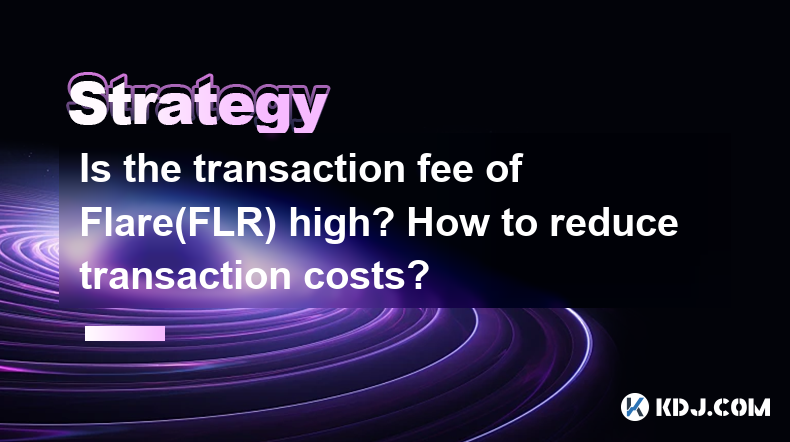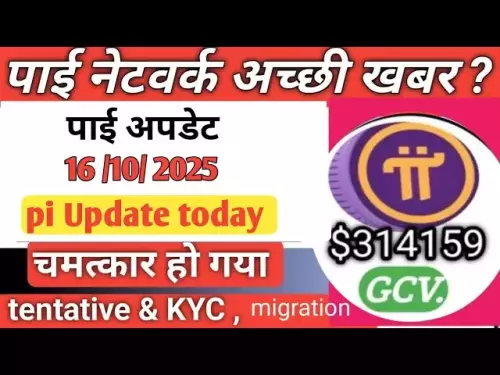-
 bitcoin
bitcoin $110918.433029 USD
-1.69% -
 ethereum
ethereum $3996.872473 USD
-2.43% -
 tether
tether $1.000594 USD
0.00% -
 bnb
bnb $1178.871834 USD
-2.38% -
 xrp
xrp $2.413973 USD
-3.47% -
 solana
solana $194.341461 USD
-4.24% -
 usd-coin
usd-coin $0.999963 USD
-0.03% -
 tron
tron $0.320092 USD
0.92% -
 dogecoin
dogecoin $0.196919 USD
-3.42% -
 cardano
cardano $0.669585 USD
-3.63% -
 hyperliquid
hyperliquid $37.485952 USD
-3.58% -
 ethena-usde
ethena-usde $1.000026 USD
-0.02% -
 chainlink
chainlink $18.018220 USD
-5.13% -
 bitcoin-cash
bitcoin-cash $523.879267 USD
-2.41% -
 stellar
stellar $0.324655 USD
-3.67%
Is the transaction fee of Flare(FLR) high? How to reduce transaction costs?
Flare's transaction fees are moderate, ranging from $0.01 to $0.10, but users can reduce costs by adjusting gas prices, timing transactions, and batching operations.
May 01, 2025 at 05:49 pm

The topic of transaction fees within the cryptocurrency ecosystem is a crucial one, especially for users of the Flare (FLR) network. This article delves into the specifics of Flare's transaction fees, examining whether they are considered high and exploring various strategies to minimize these costs. By understanding these aspects, users can optimize their transactions on the Flare network.
Understanding Flare (FLR) Transaction Fees
Flare (FLR) is a blockchain platform designed to enhance the utility of cryptocurrencies by providing a decentralized infrastructure for building applications. One of the key components of any blockchain network is its transaction fee structure. Transaction fees on Flare are typically determined by the network's demand and the complexity of the transaction. These fees are used to incentivize validators to process and confirm transactions on the network.
The fee structure on Flare is designed to be dynamic, adjusting based on the current network congestion. During periods of high demand, fees may increase to prioritize transactions, while during quieter times, fees might be lower. This dynamic pricing model helps maintain the efficiency and security of the network.
Are Flare (FLR) Transaction Fees High?
Whether Flare (FLR) transaction fees are considered high depends on several factors, including the user's perspective and the comparison with other blockchain networks. As of the latest data, Flare's average transaction fee is relatively moderate when compared to some of the more congested networks like Ethereum. However, during peak times, users might experience higher fees.
To provide a clearer picture, let's look at some specific numbers. At the time of writing, the average transaction fee on Flare might range from $0.01 to $0.10, depending on the network's current load. While this is not excessively high, users looking to minimize costs should consider various strategies to reduce their transaction fees.
Strategies to Reduce Flare (FLR) Transaction Fees
There are several effective methods that users can employ to reduce transaction costs on the Flare network. Here are some of the most practical strategies:
Adjusting Gas Prices: Similar to Ethereum, Flare uses a concept of gas to measure the computational effort required to execute transactions. Users can manually set the gas price to a lower value, which can reduce the fee. However, setting the gas price too low might result in delayed transaction confirmation.
Timing Transactions: Network congestion often varies throughout the day. By monitoring the network and choosing to execute transactions during off-peak hours, users can benefit from lower fees. Tools like block explorers can help identify these quieter periods.
Batching Transactions: If a user needs to perform multiple transactions, batching them into a single transaction can significantly reduce the overall cost. This method is particularly useful for smart contract interactions where multiple operations can be combined.
Using Layer 2 Solutions: While Flare itself does not currently have native layer 2 solutions, users might benefit from third-party services that offer similar functionalities. These solutions can process transactions off the main chain and then settle them in bulk, reducing the fees.
Detailed Steps to Adjust Gas Prices on Flare
To help users understand how to adjust gas prices on Flare, here is a detailed step-by-step guide:
Choose a Compatible Wallet: Ensure you are using a wallet that supports Flare and allows for manual gas price adjustments. Examples include MetaMask or a Flare-specific wallet.
Access Transaction Settings: When initiating a transaction, look for an option to customize the gas price. This might be labeled as 'Advanced Settings' or 'Gas Settings.'
Set a Custom Gas Price: Enter a lower gas price than the suggested one. Keep in mind that setting it too low might delay the transaction.
Confirm the Transaction: Review the transaction details and confirm. Monitor the transaction status to ensure it gets processed within a reasonable time frame.
Monitoring Network Congestion on Flare
To effectively time transactions and minimize fees, users need to monitor the Flare network's congestion. Here are some steps to do so:
Use a Block Explorer: Websites like FlareScan provide real-time data on the network's current state. Look for metrics such as the number of pending transactions and average block time.
Set Up Alerts: Some block explorers offer alert services that notify users when the network congestion drops to a certain level. This can be particularly useful for timing large or critical transactions.
Analyze Historical Data: Reviewing historical data can help users identify patterns in network congestion, allowing for better planning of future transactions.
Batching Transactions on Flare
Batching transactions is an advanced technique that can significantly reduce costs. Here's how to do it on the Flare network:
Identify Multiple Operations: Determine if you have multiple operations that can be combined into a single transaction. This is often possible with smart contracts.
Use a Compatible Tool: Some wallets and dApps offer batching capabilities. Ensure you are using a tool that supports this feature.
Create a Batch Transaction: Follow the tool's instructions to combine your operations into one transaction. This might involve writing a script or using a specific interface.
Execute the Transaction: Send the batch transaction and monitor its progress. The overall fee should be lower than if you had executed each operation separately.
Frequently Asked Questions
Q: Can I use Flare (FLR) for everyday transactions?A: Yes, Flare (FLR) can be used for everyday transactions, but users should be mindful of the fees, especially during peak times. By employing the strategies mentioned above, users can minimize costs and make Flare a viable option for regular use.
Q: How does Flare's fee structure compare to other blockchains?A: Flare's fee structure is generally more moderate than that of highly congested networks like Ethereum but might be higher than some newer, less congested blockchains. The dynamic nature of Flare's fees allows for flexibility and efficiency.
Q: Are there any risks associated with setting a low gas price on Flare?A: Yes, setting a low gas price can result in delayed transaction confirmation or, in some cases, the transaction not being processed at all. Users should balance the desire for lower fees with the need for timely transaction processing.
Q: Can I use a hardware wallet to manage Flare transactions and fees?A: Yes, hardware wallets like Ledger and Trezor can be used to manage Flare transactions. However, ensure that the wallet supports Flare and offers the necessary features for adjusting gas prices and monitoring transactions.
Disclaimer:info@kdj.com
The information provided is not trading advice. kdj.com does not assume any responsibility for any investments made based on the information provided in this article. Cryptocurrencies are highly volatile and it is highly recommended that you invest with caution after thorough research!
If you believe that the content used on this website infringes your copyright, please contact us immediately (info@kdj.com) and we will delete it promptly.
- Larry Fink and BlackRock: Tokenizing All the Assets, Baby!
- 2025-10-16 11:05:12
- Meme Coin Mania: MoonBull, FLOKI, and SHIB – What's the Buzz?
- 2025-10-16 09:10:00
- Pepeto's Presale Success: Riding the Crypto Bull Run Wave
- 2025-10-16 08:30:01
- Affordable GPUs for Gamers: A 2025 Deep Dive
- 2025-10-16 10:25:12
- Coinbase, BNB, and Token Listings: A New Era?
- 2025-10-16 09:25:16
- Secure Enclave, Flow, and Launch: What's the Buzz?
- 2025-10-16 08:30:01
Related knowledge

Practical parameter settings for a Bitcoin multi-timeframe moving average system
Sep 18,2025 at 10:54pm
Optimizing Timeframe Combinations for Bitcoin Trading1. Selecting appropriate timeframes is crucial when building a multi-timeframe moving average sys...

How can I filter out false breakouts in Dogecoin high-frequency trading?
Sep 22,2025 at 01:00am
Understanding False Breakouts in Dogecoin Trading1. A false breakout occurs when Dogecoin's price appears to move beyond a defined support or resistan...

Techniques for identifying tops and bottoms in the Bitcoin on-chain NVT model
Sep 20,2025 at 07:54pm
Understanding the NVT Model in Bitcoin Analysis1. The Network Value to Transactions (NVT) ratio is often described as the 'P/E ratio' of the cryptocur...

What does the surge in open interest in Bitcoincoin futures mean?
Sep 20,2025 at 11:18pm
Understanding the Surge in Dogecoin Futures Open Interest1. A surge in open interest within Dogecoin futures indicates a growing number of active cont...

How can I use the Ethereum USDT premium to gauge market sentiment?
Sep 18,2025 at 11:55pm
Understanding the Ethereum USDT Premium1. The Ethereum USDT premium refers to the price difference between USDT (Tether) traded on Ethereum-based plat...

What should I do if Ethereum staking yields decline?
Sep 20,2025 at 06:18am
Understanding the Causes Behind Declining Ethereum Staking Yields1. The Ethereum network transitioned to a proof-of-stake consensus mechanism with the...

Practical parameter settings for a Bitcoin multi-timeframe moving average system
Sep 18,2025 at 10:54pm
Optimizing Timeframe Combinations for Bitcoin Trading1. Selecting appropriate timeframes is crucial when building a multi-timeframe moving average sys...

How can I filter out false breakouts in Dogecoin high-frequency trading?
Sep 22,2025 at 01:00am
Understanding False Breakouts in Dogecoin Trading1. A false breakout occurs when Dogecoin's price appears to move beyond a defined support or resistan...

Techniques for identifying tops and bottoms in the Bitcoin on-chain NVT model
Sep 20,2025 at 07:54pm
Understanding the NVT Model in Bitcoin Analysis1. The Network Value to Transactions (NVT) ratio is often described as the 'P/E ratio' of the cryptocur...

What does the surge in open interest in Bitcoincoin futures mean?
Sep 20,2025 at 11:18pm
Understanding the Surge in Dogecoin Futures Open Interest1. A surge in open interest within Dogecoin futures indicates a growing number of active cont...

How can I use the Ethereum USDT premium to gauge market sentiment?
Sep 18,2025 at 11:55pm
Understanding the Ethereum USDT Premium1. The Ethereum USDT premium refers to the price difference between USDT (Tether) traded on Ethereum-based plat...

What should I do if Ethereum staking yields decline?
Sep 20,2025 at 06:18am
Understanding the Causes Behind Declining Ethereum Staking Yields1. The Ethereum network transitioned to a proof-of-stake consensus mechanism with the...
See all articles


























![Web3 Crypto Market Morning Report: The market is in decline, altcoins have fallen by more than 5%, Binance compensation has been received, and Memes on the Bnb chain have collectively plummeted [Vic TALK Issue 1444] Web3 Crypto Market Morning Report: The market is in decline, altcoins have fallen by more than 5%, Binance compensation has been received, and Memes on the Bnb chain have collectively plummeted [Vic TALK Issue 1444]](/uploads/2025/10/16/cryptocurrencies-news/videos/web-crypto-market-morning-report-market-decline-altcoins-fallen-binance-compensation-received-memes-bnb-chain-collectively-plummeted-vic-talk-issue/68f043c9c8b44_image_500_375.webp)















































